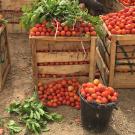Published in July 2019, this report was written by team members from the Institut de l'Environnement et de Recherches Agricoles du Burkina Faso (INERA), including Dr. Some Koussao, Nikiema Jeanne and Sawadogo Irmean as part of the Horticulture Innovation Lab's project focused on improving postharvest practices for tomatoes in Burkina Faso.
Background
In Burkina Faso, tomato production is increasing steadily, consistent with the market growth and increased demand. However, several factors are constraining tomato production, including:
- increasing pest pressure
- intensified chemical treatments
- high postharvest losses (ranging from 20-60%)
Around 80 percent of tomatoes are produced during the dry season, resulting in a glut in the market. In contrast, tomatoes are scarce during the rainy season, which results in increased cost and reduced accessibility for consumers. Reduced yield occurs during the rainy season because of:
- lack of varieties adapted to the rainy season
- increased prevalence of diseases
- poor agronomic practices
Study objectives
- Identify suitable tomato varieties for rainy season production
- Improve rainy season production practices, including disease and pest control. as well as agronomic practices
Methodology
- Varieties: Four tomato varieties known for their adaptation to rainy season production were tested
- Selection of producers: 17 tomato producers were identified to conduct trials
- Establishing nurseries: One mound-type nursery was constructed in each of the seven communities in July 2017. Organic manure was applied to seedbeds, and seeds of each variety were treated with fungicide before sowing. Nitrogen, phosphorus and potassium (NPK) fertilizer and urea were also applied.
- Field evaluation: Farmers transplanted seedlings into their own fields, 28 days after nursery production. More NPK and urea were applied.
- Field visits: Two field visits, one at the full vegetation stage and the second at harvest, were organized in a participatory manner and included farmers, Catholic Relief Services staff, and INERA staff.
Main findings
The results from the 2018 trials were affected by the seasonal rainfall that resulted in flooding, especially in the lowland area.
At the nursery stage, the majority of young plants were lost due to heavy rains and flooding. The survival rate of plants varied among different locations and varieties tested.
Field days and field evaluation findings
- The pest attacks observed during field days varied among locations.
- At all the locations, the best performing variety was Mongal, which has better tolerance to diseases, pests, and waterlogging.
- The other varieties showed intermediate behavior.
- During the harvest field day, farmers’ evaluation of each variety was based on its yield performance and the quality of fruits harvested.
- After the field evaluation, Mongal and FBT3 were the best varieties among the four tested.
- During 2017 trials, farmers identified AVTO 1122 and Mongal as varieties with a good growth ability and production.
- The INERA variety FBT3 was very healthy in the nursery and field, but had poor branching.
- The ICRISINA, Petomech, and COBRA varieties had serious health issues as they were susceptible to fungal, bacterial, viral diseases and insect damage.
Conclusion
Successful tomato production in the rainy season requires a combination of good agronomic practices as well as pest and disease control. However, the availability of suitable varieties remains the critical factor for successful tomato production during the rainy season.
See the whole report for conclusions based on data from two years of farmer field trials and farmer feedback, on the fruit quality and general performance of each variety for rainy season cultivation in Burkina Faso.

